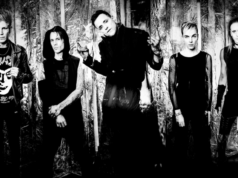
Today marks the 43rd anniversary of John Lennon‘s tragic assassination. Even decades later, few deaths in the history of Western music have evoked such a global response of mourning and appreciation for one of rock’s most influential songwriters and poets. Lennon’s musical contribution was enormous, his pathos and introspective soul spoke to a nation of lost British souls, and then to the rest of the world.
John Winston Lennon was born on October 9th, 1940, into a working-class family in Liverpool, England. His early life was difficult. His father took off to the seas, leaving his young mother to raise her son alone. When he was a teenager, Lennon’s mother was killed in an auto accident. Lacking parental guidance, Lennon was a troubled youth, prone to rage and anger. Eventually, he channeled his passion for art school and music.
As did many youths of his generation, Lennon turned to art as an outlet of expression, notably American rock and R&B pioneers due to the styles’ sheer energy and unabashed disregard for authority. Lennon took to music like a magnet to steel. Forming a friendship with Paul McCartney and then George Harrison, they formed a band that played covers of their favorite American artists–Elvis, Chuck Berry, Buddy Holly, Carl Perkins to name a few. While the lives of Lennon and his bandmates were in disarray, the focus of the band and their music became a unifying force giving the band a purpose and raison d’etre.
His band–first the Quarrymen, to the Silver Beetles, then finally The Beatles–crafted a sound in first half of the 1960s that pushed commercial music and youth culture to new horizons never seen or heard before.
The thing about Lennon was his ability to speak for a generation. As he grew, the rest of the world grew with him. Lennon and The Beatles’ early career was filled with radio-friendly rock songs and elegant love ballads. The spirit and charisma of these songs captured the attention of teenagers around the world. But if it were just based on these early songs, the Beatles’ legacy would’ve been the same as The Dave Clark 5 or Herman Hermits. It was The Beatles’ later studio efforts with help from producer Sir George Martin that really showcased their collective songwriting abilities.
Take, for example, the lyrics to “In My Life” from 1965’s Rubber Soul:
There are places I remember all my life, though some have changed.
Some forever, not for better. And some have gone, and some remain.
All these places have their moments with lovers and friends I still can’t recall.
Some are dead and some are living. In my life I love them all.
All these years later, it remains a very moving song.
Lennon matured as an artist, dipping into the existential world of life’s finality. Soaring songs from Revolver (1966) such as “She Said She Said” with the iconic “I know what it’s like to be dead, I know what it’s like to be sad,” to the netherworld from “Tomorrow Never Knows”:
Turn off your mind, relax and float downstream – It is not dying, it is not dying
Lay down all thoughts, surrender to the void – It is shining, it is shining
Yet you may see the meaning of within – It is being, it is being
Love is all and love is everyone – It is knowing, it is knowing
And ignorance and hate mourn the dead – It is believing, it is believing
But listen to the colour of your dreams – It is not leaving, it is not leaving
So play the game “Existence” to the end – Of the beginning, of the beginning
If Lennon’s career had ended there, he still would’ve been my generation’s greatest poet. In 1966, rock critics said after Revolver, the Beatles were done… that there was nothing left to contribute. Wrong. Very Wrong. Lennon turned inside out, from introspection to statements of exploration and reflections of society. Then Sgt. Pepper’s (1967) was released, a thematic album of psychedelic brilliance that literally and figuratively turned the world on.
Magical Mystery Tour (1967) came next, a trippy ride into the world of the bizarre. Lennon (with a little help from Sir Paul) gave us “Lucy in the Sky With Diamonds”, “Strawberry Fields Forever” and the iconic “A Day in the Life”. Each a masterpiece. Just when the world was thinking that the Beatles were a bunch of self-involved hippie druggies, we get “All You Need is Love”, an anthem of love and forgiveness. But not to be too soft, Lennon then gave us “Revolution”, daring the world to “show me what you got.” One of his final Beatles contributions, “I Want You/She’s So Heavy” is a song of unbridled passion. The song’s abrupt ending mirrors the act of love itself. Brilliant!
In the years after their breakup, Lennon’s popularity and influence remained undiminished because he always seemed so accessible. He had a sharp and witty sense of humor but was also sensitive and capable of deep love. He was able to get under our skin, into our hearts and souls. Personally, it almost felt like he spoke for the baby boomer generation. Singing songs of emotions I felt but could not express.
We must take time to celebrate Lennon’s life, his music, and his contribution. He may be gone, but never to be forgotten. Thank you, John.
The post Remembering John Lennon’s Life And Legacy On The 43rd Anniversary Of His Death appeared first on L4LM.


![Trapped In Time: Phish Welcomes Fans To First Night Of Jams At Las Vegas’ Sphere [Photos/Videos] Screen Shot 2024 04 05 at 12.03.26 PM](https://utterbuzz.com/wp-content/uploads/2024/04/Screen-Shot-2024-04-05-at-12.03.26-PM-238x178.png)
![Trey Anastasio Talks Delivering A “Psychedelic” Experience At Sphere With CBS, SiriusXM [Videos]](https://utterbuzz.com/wp-content/uploads/2024/04/trey-anastasio-talks-delivering-a-psychedelic-experience-at-sphere-with-cbs-siriusxm-videos-238x178.jpg)




